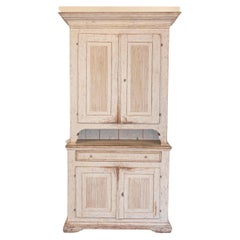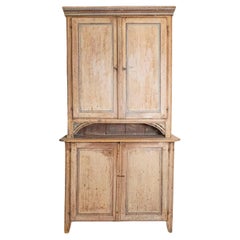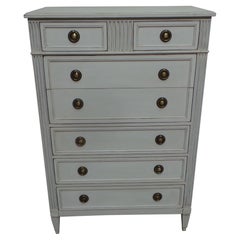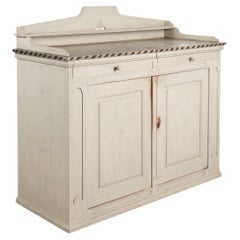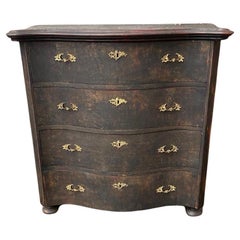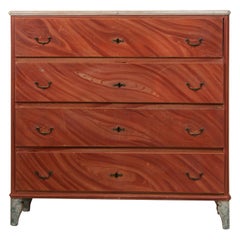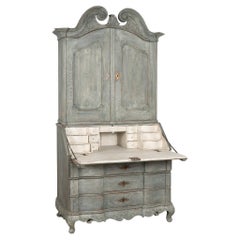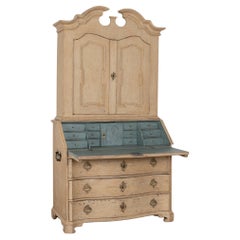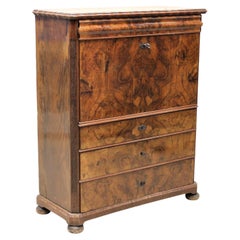Gustavian Tall Cabinet
Antique Early 19th Century Swedish Gustavian Cabinets
Wood
Antique Late 18th Century Swedish Gustavian Cabinets
Wood
Vintage 1940s Swedish Gustavian Commodes and Chests of Drawers
Wood
Antique Mid-19th Century Swedish Gustavian Sideboards
Pine, Paint
Antique Mid-19th Century Scandinavian Gustavian Commodes and Chests of D...
Brass
Antique Early 19th Century Swedish Gustavian Commodes and Chests of Drawers
Pine
Antique Late 18th Century Swedish Gustavian Secretaires
Oak, Paint
Antique Early 19th Century Swedish Gustavian Secretaires
Brass
Antique Early 19th Century Swedish Gustavian Secretaires
Wood
Antique Early 19th Century Swedish Gustavian Secretaires
Wood, Burl
Antique 1840s Danish Gustavian Cabinets
Wood
Antique Early 19th Century Swedish Gustavian Cabinets
Wood
Antique 1880s Swedish Gustavian Commodes and Chests of Drawers
Wood
Antique Late 18th Century Swedish Gustavian Corner Cupboards
Pine
Antique Early 19th Century Swedish Gustavian Cabinets
Wood
Antique 1880s Swedish Gustavian Dressers
Wood
Antique 1890s Swedish Gustavian Dressers
Wood
Antique Late 18th Century Swedish Gustavian Wardrobes and Armoires
Pine
Antique Mid-19th Century Swedish Gustavian Cabinets
Wood, Paint
Antique Late 19th Century Swedish Gustavian Bookcases
Wood, Paint
Antique Late 19th Century Swedish Gustavian Bookcases
Glass, Wood, Paint
Antique 1880s European Gustavian Dressers
Wood
Antique 1880s Swedish Gustavian Dressers
Wood
Antique Early 1800s Swedish Gustavian Cabinets
Brass
Antique 18th Century Swedish Gustavian Cupboards
Wood
Antique Early 19th Century Swedish Gustavian Sideboards
Pine
Antique 1880s Swedish Gustavian Commodes and Chests of Drawers
Wood
Antique 1820s Swedish Gustavian Secretaires
Pine
Antique Late 18th Century Swedish Gustavian Secretaires
Glass, Wood
Antique Early 19th Century Swedish Gustavian Secretaires
Wood
Antique Early 19th Century Swedish Gustavian Secretaires
Wood
Antique Late 19th Century Swedish Gustavian Sideboards
Pine, Paint
Antique 19th Century Swedish Commodes and Chests of Drawers
Antique Mid-19th Century Scandinavian Gustavian Commodes and Chests of D...
Brass
Antique 18th Century Swedish Gustavian Commodes and Chests of Drawers
Brass
Antique Early 19th Century Swedish Gustavian Commodes and Chests of Drawers
Wood
Antique 19th Century Swedish Cabinets
Wood
Antique Late 19th Century Swedish Gustavian Bookcases
Glass, Pine, Paint
Antique 19th Century Swedish Gustavian Cupboards
Wood
Antique Late 18th Century Swedish Gustavian Wardrobes and Armoires
Iron
Antique Mid-19th Century Swedish Gustavian Cupboards
Pine
Antique Mid-19th Century Swedish Gustavian Cupboards
Pine
Antique Late 19th Century Swedish Gustavian Sideboards
Pine, Paint
Antique 19th Century Swedish Gustavian Secretaires
Wood
Antique Mid-19th Century Swedish Gustavian Cupboards
Pine
Antique Mid-19th Century Swedish Gustavian Cupboards
Pine, Paint
Antique Early 19th Century Swedish Gustavian Secretaires
Wrought Iron
Antique Early 19th Century Swedish Gustavian Desks
Brass
Antique Early 19th Century Swedish Gustavian Secretaires
Brass
Antique Late 19th Century European Gustavian Commodes and Chests of Drawers
Pine
Antique Early 19th Century Danish Gustavian Commodes and Chests of Drawers
Paint, Pine
Antique Late 19th Century Swedish Country Bookcases
Glass, Pine, Paint
Antique Early 19th Century Swedish Gustavian Cabinets
Paint
Antique Early 19th Century Swedish Gustavian Cabinets
Pine
Antique Late 18th Century Swedish Gustavian Cabinets
Pine
Mid-20th Century Swedish Gustavian Bookcases
Brass
Antique Mid-19th Century Swedish Gustavian Sideboards
Wood, Paint
Antique Mid-19th Century Swedish Gustavian Sideboards
Pine
Antique Late 18th Century Swedish Gustavian Cabinets
Pine
Antique Mid-19th Century Swedish Gustavian Cabinets
Wood, Paint
- 1
Gustavian Tall Cabinet For Sale on 1stDibs
How Much is a Gustavian Tall Cabinet?
A Close Look at Gustavian Furniture
With clean lines and muted colors, antique Gustavian furniture is understated and elegant. It represents a more restrained version of the transition from Rococo to neoclassicism that was happening in France under Louis XVI. The style developed under Swedish King Gustav III, who reigned from 1771 until his assassination in 1792, and his son Gustav IV, who ruled until 1809. Although Gustavian furniture is mostly used to refer to pale painted cabinets, commodes, armchairs and other items, it involved a range of influences.
Gustavian-style furniture was inspired by discoveries at Pompeii and Herculaneum as well as the grandeur of European palaces like Versailles, with local softwoods such as pine and birch. There was also an emphasis on natural light; crystal chandeliers and large mirrors played a role in radiating the fleeting daylight of winter, giving it a distinctive aesthetic.
Where earlier furniture was curvy and florid, this new era was more architectural, with tapered and fluted legs and rectangular and oval shapes. Luminous gilt contrasted with the palette of soft blues on upholstery and painted surfaces. Leading furniture builders included Gottlieb Iwersson, Louis Masreliez and Erik Öhrmark. The latter, a French-born Swedish decorator, designed the Sulla chair, a seat that was demonstrative of technical skill and precise craftsmanship and drew on Greek klismos chairs. Masreliez’s Sulla chair was made by Öhrmark and featured decorative ornamentation produced by Jean-Baptiste Masreliez, Louis’s younger brother.
While the wealthy had furniture carved with neoclassical details like scallops and rosettes, more affordable options were adorned with faux finishes that mimicked marble and stenciled patterns. The simple elegance of Gustavian furniture would have a long impact on Swedish design, informing the 20th-century appreciation for function and form. In the 1950s, IKEA mass-produced copies of a Gustavian commode designed by cabinetmaker Georg Haupt, who created pieces for the Royal Palace, making the furniture a fixture of everyday Swedish life.
Find a collection of antique Gustavian seating, tables, decorative objects and other furniture on 1stDibs.
Finding the Right Case Pieces And Storage Cabinets for You
Of all the vintage storage cabinets and antique case pieces that have become popular in modern interiors over the years, dressers, credenzas and cabinets have long been home staples, perfect for routine storage or protection of personal items.
In the mid-19th century, cabinetmakers would mimic styles originating in the Louis XIV, Louis XV and Louis XVI eras for their dressers, bookshelves and other structures, and, later, simpler, streamlined wood designs allowed these “case pieces” or “case goods” — any furnishing that is unupholstered and has some semblance of a storage component — to blend into the background of any interior.
Mid-century modern furniture enthusiasts will cite the tall modular wall units crafted in teak and other sought-after woods of the era by the likes of George Nelson, Poul Cadovius and Finn Juhl. For these highly customizable furnishings, designers of the day delivered an alternative to big, heavy bookcases by considering the use of space — and, in particular, walls — in new and innovative ways. Mid-century modern credenzas, which, long and low, evolved from tables that were built as early as the 14th century in Italy, typically have no legs or very short legs and have grown in popularity as an alluring storage option over time.
Although the name immediately invokes images of clothing, dressers were initially created in Europe for a much different purpose. This furnishing was initially a flat-surfaced, low-profile side table equipped with a few drawers — a common fixture used to dress and prepare meats in English kitchens throughout the Tudor period. The drawers served as perfect utensil storage. It wasn’t until the design made its way to North America that it became enlarged and equipped with enough space to hold clothing and cosmetics. The very history of case pieces is a testament to their versatility and well-earned place in any room.
In the spirit of positioning your case goods center stage, decluttering can now be design-minded.
A contemporary case piece with open shelving and painted wood details can prove functional as a storage unit as easily as it can a room divider. Alternatively, apothecary cabinets are charming case goods similar in size to early dressers or commodes but with uniquely sized shelving and (often numerous) drawers.
Whether you’re seeking a playful sideboard that features colored glass and metal details, an antique Italian hand-carved storage cabinet or a glass-door vitrine to store and show off your collectibles, there are options for you on 1stDibs.
- How tall are filing cabinets?1 Answer1stDibs ExpertFebruary 22, 2021Filing cabinets are anywhere from 29 inches to 60 inches tall. The height of these cabinets is dependent on the number of drawers. The width of these cabinets are 15” or 18 ¼ inches wide for legal size.
- 1stDibs ExpertMarch 31, 2023How tall a four-drawer file cabinet is varies. However, most are at least 52 inches to accommodate four levels of standard-size hanging file folders, which are around 9.25 inches high. Find a variety of filing cabinets on 1stDibs.
